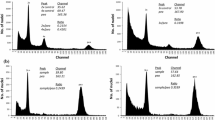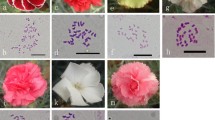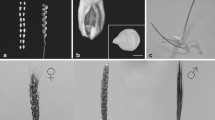Summary
Gilia millefoliata andG. achilleaefolia, two annual diploid (n=9) species ofPolemoniaceae, crossed readily in certain combinations but not in others. The F1 hybrids were vigorous but sterile. They gave rise, apparently by the union of unreduced gametes, to an F2 generation of tetraploids, which were mostly fertile.
Chromosome pairing in the hybrids varied markedly according to the state of nutrition of the plants. The F1 hybrids formed fewer clear diakinesis figures, fewer bivalents, fewer chiasmata per bivalent, and more attenuated or stretched bivalents when grown in 2″ pots of sand than when grown in rich soil (Table 3). A pot-bound allotetraploid individual derived from this hybrid showed the same meiotic irregularities as the starved F1s until irrigated with a solution of mineral nutrients, after which its chromosomes paired regularly in bivalents (Table 2, Fig. 38).
The capacity of the F1 hybrids to produce polyploids also differed strikingly in the two cultures. The rate of polyploidy of the stunted sand-grown hybrids was 2381 viable tetraploid zygotes per million flowers, while the corresponding figure for the luxuriant field hybrids was only 2.7 per million flowers.
For the production of polyploid progeny by diploid parents — a process which should be clearly distinguished from normal fertility — the termpolyploidy rate is proposed. It is suggested that starvation of a structural hybrid may sometimes increase its polyploidy rate by reducing chromosome pairing to the point where restitution nuclei and hence unreduced gametes can be formed.
Similar content being viewed by others
References
Bradley, Muriel: A method for making aceto-carmine squashes permanent without removal of the cover slip. Stain Teohnol.23, 41–44 (1948).
Darlington, C. D.: Recent advances in cytology, 2. ed., London 1937.
Dickinson, S.: Experiments on the physiology and genetics of the smut fungi. Cultural characters. II. The effect of certain external conditions on their segregation. Proc. Roy. Soc.108, 395–423 (1931).
Ehrenberg, C. E.: Studies on asynapsis in the elm,Ulmus glabra Huds. Heredity35, 1–26 (1949).
Grant, V.: Genetic and taxonomic studies inGilia. V.Gilia clivorum. El Aliso3 (in press).
Gregory, W. C.: Experimental studies on the cultivation of excised anthers in nutrient solution. Amer. J. Bot.27, 687–692 (1940).
Müntzing, A., andS. Akdik: Cytological disturbances in the first inbred generations of rye. Hereditas34, 485–509 (1948).
Straub, J.: Untersuchungen zur Physiologie der Meiosis. VII. Die Abhängigkeit der Chiasmabildung beiVicia faba undCampanula persicifolia von äußeren Bedingungen. Z. Bot.32, 225–268 (1938).
Taylor, J. H.: The duration of differentiation in excised anthers. Amer. J. Bot.37, 137–143 (1950).
Walters, Marta: Spontaneous breakage and reunion of meiotic chromosomes in the hybridBromus trinii ×B. maritimus. Genetics35, 11–37 (1950).
—: Spontaneous chromosome breakage and atypical chromosome movement in meiosis of the hybridBromus marginatus ×B. pseudolaevipes. Genetics37, 8–25 (1952).
Zürn, K.: Untersuchungen zur Physiologie der Meiosis. IX. Die Bedeutung der Plastiden für den Ablauf der Meiosis. Jb. wiss. Bot.85, 706–731 (1937).
—: Untersuchungen zur Physiologie der Meiosis. X. Neue Beiträge zur Kenntnis des Einflusses der Plastiden auf den Ablauf der Meiosis. Z. Bot.34, 273–310 (1939).
Author information
Authors and Affiliations
Rights and permissions
About this article
Cite this article
Grant, V. Cytogenetics of the hybrid Gilia millefoliata × achilleaefolia. Chromosoma 5, 372–390 (1953). https://doi.org/10.1007/BF01271494
Received:
Issue Date:
DOI: https://doi.org/10.1007/BF01271494




